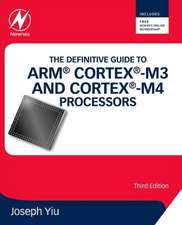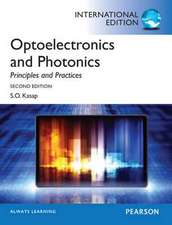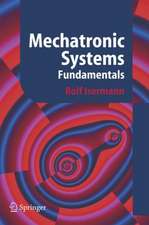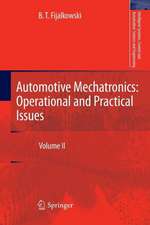Nanoscale Devices: Fabrication, Functionalization, and Accessibility from the Macroscopic World: NanoScience and Technology
Autor Gianfranco Cerofolinien Limba Engleză Hardback – 7 sep 2009
| Toate formatele și edițiile | Preț | Express |
|---|---|---|
| Paperback (1) | 636.80 lei 6-8 săpt. | |
| Springer Berlin, Heidelberg – 14 mar 2012 | 636.80 lei 6-8 săpt. | |
| Hardback (1) | 645.79 lei 6-8 săpt. | |
| Springer Berlin, Heidelberg – 7 sep 2009 | 645.79 lei 6-8 săpt. |
Din seria NanoScience and Technology
- 24%
 Preț: 905.79 lei
Preț: 905.79 lei - 18%
 Preț: 1123.35 lei
Preț: 1123.35 lei - 18%
 Preț: 964.71 lei
Preț: 964.71 lei - 18%
 Preț: 1121.76 lei
Preț: 1121.76 lei - 15%
 Preț: 655.60 lei
Preț: 655.60 lei - 18%
 Preț: 1390.11 lei
Preț: 1390.11 lei - 18%
 Preț: 954.31 lei
Preț: 954.31 lei - 18%
 Preț: 953.03 lei
Preț: 953.03 lei - 18%
 Preț: 945.79 lei
Preț: 945.79 lei - 15%
 Preț: 639.90 lei
Preț: 639.90 lei - 18%
 Preț: 1109.16 lei
Preț: 1109.16 lei - 23%
 Preț: 779.87 lei
Preț: 779.87 lei - 18%
 Preț: 944.99 lei
Preț: 944.99 lei - 18%
 Preț: 957.62 lei
Preț: 957.62 lei - 18%
 Preț: 971.01 lei
Preț: 971.01 lei - 18%
 Preț: 1232.26 lei
Preț: 1232.26 lei - 18%
 Preț: 960.30 lei
Preț: 960.30 lei - 15%
 Preț: 646.62 lei
Preț: 646.62 lei - 18%
 Preț: 1249.31 lei
Preț: 1249.31 lei - 15%
 Preț: 636.80 lei
Preț: 636.80 lei - 18%
 Preț: 1232.26 lei
Preț: 1232.26 lei - 24%
 Preț: 821.43 lei
Preț: 821.43 lei - 18%
 Preț: 948.92 lei
Preț: 948.92 lei - 24%
 Preț: 1827.89 lei
Preț: 1827.89 lei - 18%
 Preț: 951.91 lei
Preț: 951.91 lei - 24%
 Preț: 794.21 lei
Preț: 794.21 lei - 18%
 Preț: 953.03 lei
Preț: 953.03 lei - 23%
 Preț: 782.55 lei
Preț: 782.55 lei - 18%
 Preț: 952.57 lei
Preț: 952.57 lei - 18%
 Preț: 948.16 lei
Preț: 948.16 lei - 18%
 Preț: 954.93 lei
Preț: 954.93 lei - 24%
 Preț: 809.40 lei
Preț: 809.40 lei - 23%
 Preț: 781.25 lei
Preț: 781.25 lei - 18%
 Preț: 954.93 lei
Preț: 954.93 lei - 18%
 Preț: 1830.34 lei
Preț: 1830.34 lei - 15%
 Preț: 641.71 lei
Preț: 641.71 lei - 18%
 Preț: 1228.96 lei
Preț: 1228.96 lei - 18%
 Preț: 1120.37 lei
Preț: 1120.37 lei - 18%
 Preț: 956.81 lei
Preț: 956.81 lei - 15%
 Preț: 592.59 lei
Preț: 592.59 lei - 18%
 Preț: 953.65 lei
Preț: 953.65 lei - 18%
 Preț: 954.62 lei
Preț: 954.62 lei - 18%
 Preț: 955.25 lei
Preț: 955.25 lei - 18%
 Preț: 959.19 lei
Preț: 959.19 lei - 18%
 Preț: 953.35 lei
Preț: 953.35 lei - 18%
 Preț: 786.84 lei
Preț: 786.84 lei
Preț: 645.79 lei
Preț vechi: 759.76 lei
-15% Nou
Puncte Express: 969
Preț estimativ în valută:
123.57€ • 129.03$ • 102.04£
123.57€ • 129.03$ • 102.04£
Carte tipărită la comandă
Livrare economică 15-29 aprilie
Preluare comenzi: 021 569.72.76
Specificații
ISBN-13: 9783540927310
ISBN-10: 354092731X
Pagini: 242
Ilustrații: XVI, 205 p. 84 illus., 54 illus. in color.
Dimensiuni: 155 x 235 x 18 mm
Greutate: 0.57 kg
Ediția:2009
Editura: Springer Berlin, Heidelberg
Colecția Springer
Seria NanoScience and Technology
Locul publicării:Berlin, Heidelberg, Germany
ISBN-10: 354092731X
Pagini: 242
Ilustrații: XVI, 205 p. 84 illus., 54 illus. in color.
Dimensiuni: 155 x 235 x 18 mm
Greutate: 0.57 kg
Ediția:2009
Editura: Springer Berlin, Heidelberg
Colecția Springer
Seria NanoScience and Technology
Locul publicării:Berlin, Heidelberg, Germany
Public țintă
ResearchCuprins
Basics.- Matter on the Nanoscale.- Top-Down Paradigm to Miniaturization.- Physical Limits to Miniaturization.- The Crossbar Structure.- Crossbar Production.- The Litho-to-Nano link.- Functional Molecules.- Grafting Functional Molecules.- Advanced Topics:Self-similar structures, molecular motors, nanobiosystems.- Examples.- Self-Similar Nanostructures.- Molecular Motors.- Nanobiosensing.- Abstract Technology.
Notă biografică
Gianfranco ("GF") Cerofolini (degree in Physics from the University of Milan, 1970) is visiting researcher at the University of Milano-Bicocca. His major interests are addressed to the physical limits of miniaturization and to the 'emergence' of higher-level phenomena from the underlying lower-level substrate (measurement in quantum mechanics, life in biological systems, etc.).
Although his research activity has been carried out in the industry (vacuum: SAES Getters; telecommunication: Telettra; chemistry and energetics: ENI; integrated circuits: STMicroelectronics), he has had frequent collaborations with academic centers (University of Lublin, IMEC, Stanford University, City College of New York, several Italian Universities), has been lecturer in a few Universities (Pisa, Modena, and Polytechnic of Milan), and currently is lecturer at the University of Milano-Bicocca.
His research has covered several areas: adsorption, biophysics, CMOS processing (oxidation, diffusion, ion implantation, gettering), electronic and optical materials, theory of acidity, and nanoelectronics.
A gettering technique of widespread use in microelectronics, the complete setting of ST's first silicon-gate CMOS process, the development of a process for low-fluence SOI, and the identification of a strategy for molecular electronics via a conservative extension of the existing microelectronic technology, are among his major industrial achievements. His main scientific results range from the preparation and characterization of ideal silicon p-n junctions and the discovery of a mechanism therein of pure generation without recombination, to the theoretical description of layer-by-layer oxidation at room temperature of silicon, and to the development of original mathematical techniques for the description of adsorption on heterogeneous or soft surfaces.
The results of his activity have been published in approximately 300 articles, chapters to books, and encyclopaedic items, and in a score of patents.
Although his research activity has been carried out in the industry (vacuum: SAES Getters; telecommunication: Telettra; chemistry and energetics: ENI; integrated circuits: STMicroelectronics), he has had frequent collaborations with academic centers (University of Lublin, IMEC, Stanford University, City College of New York, several Italian Universities), has been lecturer in a few Universities (Pisa, Modena, and Polytechnic of Milan), and currently is lecturer at the University of Milano-Bicocca.
His research has covered several areas: adsorption, biophysics, CMOS processing (oxidation, diffusion, ion implantation, gettering), electronic and optical materials, theory of acidity, and nanoelectronics.
A gettering technique of widespread use in microelectronics, the complete setting of ST's first silicon-gate CMOS process, the development of a process for low-fluence SOI, and the identification of a strategy for molecular electronics via a conservative extension of the existing microelectronic technology, are among his major industrial achievements. His main scientific results range from the preparation and characterization of ideal silicon p-n junctions and the discovery of a mechanism therein of pure generation without recombination, to the theoretical description of layer-by-layer oxidation at room temperature of silicon, and to the development of original mathematical techniques for the description of adsorption on heterogeneous or soft surfaces.
The results of his activity have been published in approximately 300 articles, chapters to books, and encyclopaedic items, and in a score of patents.
Textul de pe ultima copertă
The evolution of the microelectronics is controlled by the idea of scaling. However, the scaling of the device size below 10 nm is expected to be impossible because of physical, technological and economic reasons. Fundamental considerations (based on Heisenberg's principle, Schrödinger equation, decoherence of quantum states, and Landauer limit) suggest that a length scale of a few nanometers is possible. On this length scale, reconfigurable molecules (via redox or internal excitation processes) seem to be suitable for that. Moreover, crossbar with cross-point density in the range 1010--1011 cm-² can already be prepared with existing methods, and such methods permit the link of nanoscopic cross-points to lithographically accessible contacts. The structures for molecular electronics deal with molecules. Although this subject is highly interdisciplinary (covering quantum and statistical mechanics, supramolecular chemistry, chemistry of surfaces, and silicon technology and devices), the book is intended to be self-contained providing in appendices the necessary side knowledge.
Caracteristici
Deals with the miniaturization of electronic devices towards the nanoscale Presents the concept of nanolithography and nanodevices A reference work for researchers and engineers alike Includes supplementary material: sn.pub/extras















